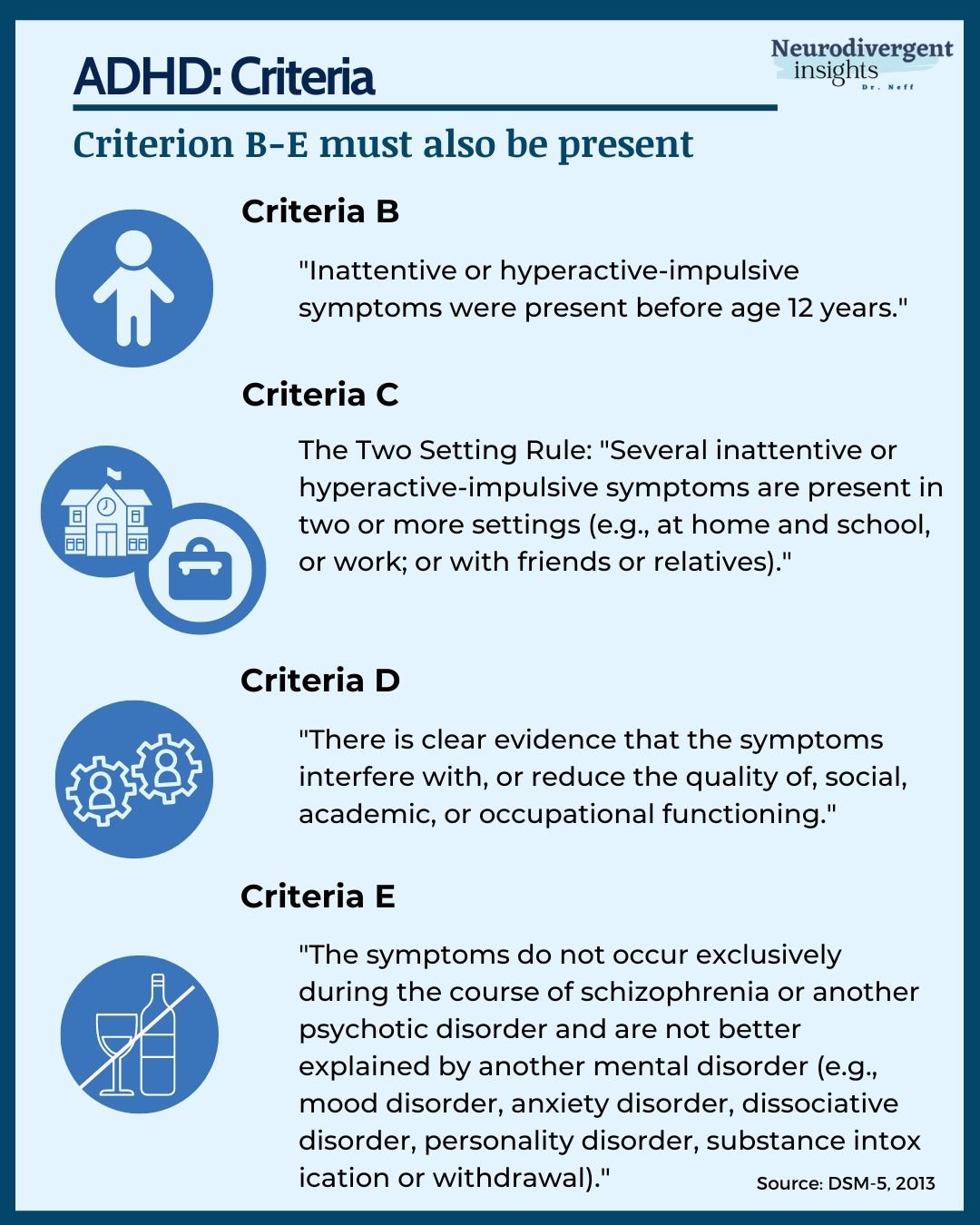Understanding Adult ADHD: Diagnosis And Next Steps

Table of Contents
Recognizing the Signs of Adult ADHD
Adult ADHD doesn't always manifest in the same way as it does in children. While hyperactivity might be less pronounced, the core symptoms of inattentiveness, hyperactivity, and impulsivity remain present, albeit in different forms. Recognizing these signs is the first step towards seeking help.
Common Symptoms in Adults
Adults with ADHD often experience challenges in several key areas. Instead of the constant fidgeting often associated with childhood ADHD, adults might struggle with internal restlessness, difficulty focusing on tasks for extended periods, and chronic disorganization. Impulsivity can lead to rash decisions, financial difficulties, or strained relationships.
- Difficulty concentrating at work or during leisure activities: This can manifest as frequent mind-wandering, difficulty completing tasks, or struggling to stay focused on conversations.
- Problems managing time and meeting deadlines: Procrastination becomes a significant obstacle, leading to missed deadlines and increased stress levels.
- Impulsive spending or decision-making: Uncontrolled spending sprees or making quick, poorly considered decisions can negatively impact finances and well-being.
- Feeling easily overwhelmed or frustrated: Adults with ADHD often experience heightened sensitivity to stress and may struggle to cope with everyday demands.
- Trouble prioritizing tasks: Difficulty distinguishing between urgent and important tasks can lead to feelings of being overwhelmed and unproductive.
- Restlessness and difficulty relaxing: Constant mental activity can make it difficult to relax or unwind, leading to sleep disturbances and increased anxiety.
- Challenges with emotional regulation: Experiencing intense emotional swings and difficulty managing frustration or anger are common symptoms.
These symptoms can significantly affect your work, relationships, and overall well-being. If you relate to many of these points, it's essential to explore the possibility of Adult ADHD. Recognizing the signs of Adult ADHD, specifically inattentive ADHD, hyperactive ADHD, or combined-type ADHD, is vital for initiating the diagnostic process.
The Diagnostic Process for Adult ADHD
Diagnosing Adult ADHD requires a comprehensive assessment by a qualified professional. Self-diagnosis is unreliable and can lead to inappropriate treatment.
Seeking Professional Help
The first step is to consult a qualified healthcare professional experienced in diagnosing and treating ADHD in adults. This might be a psychiatrist, psychologist, or clinical neuropsychologist. They can provide accurate diagnosis and create a tailored treatment plan.
Comprehensive Assessment
The diagnostic process typically involves:
- A thorough medical history: This helps rule out other conditions that may present with similar symptoms.
- Clinical interviews: The professional will ask detailed questions about your history, symptoms, and daily challenges.
- Questionnaires: Standardized questionnaires like the ASRS (Adult ADHD Self-Report Scale) and Conner's Adult ADHD Rating Scales help assess the presence and severity of ADHD symptoms.
- Neuropsychological testing: In some cases, neuropsychological testing may be used to evaluate cognitive functioning and rule out other neurological conditions. This testing helps differentiate Adult ADHD from other conditions that share similar symptoms.
The difference between self-diagnosis and professional diagnosis is crucial. A professional diagnosis ensures accurate identification and the creation of an effective treatment plan. It's important to remember that ruling out other potential conditions is a vital part of the Adult ADHD assessment process.
Treatment Options for Adult ADHD
Once diagnosed, several effective treatment options are available to help manage Adult ADHD symptoms and improve quality of life.
Medication Management
Medication is often a cornerstone of Adult ADHD treatment. Stimulant medications like methylphenidate and amphetamine are commonly prescribed, but non-stimulant options such as atomoxetine are also available. The choice of medication and dosage is highly individualized and determined in consultation with your healthcare professional. Remember that medication management should be done under strict professional supervision due to potential side effects.
Therapy and Behavioral Interventions
Therapy plays a vital role in supplementing medication and developing coping mechanisms. Cognitive Behavioral Therapy (CBT) is particularly effective in teaching strategies for managing impulsivity, improving organization, and developing better time management skills. ADHD coaching can provide additional support and personalized strategies.
- Medication options: Stimulants (e.g., methylphenidate, amphetamine), non-stimulants (e.g., atomoxetine).
- Therapy types: CBT, behavioral therapy, support groups.
- Lifestyle adjustments: Prioritizing sleep hygiene, a balanced diet, and regular exercise can significantly impact symptom management. These lifestyle changes are an important part of a comprehensive treatment plan for Adult ADHD.
Living Well with Adult ADHD
Managing Adult ADHD is an ongoing process. However, with the right strategies and support, you can live a fulfilling and successful life.
Developing Coping Strategies
Developing effective coping strategies is crucial for managing daily challenges.
- Time management techniques: Time blocking, prioritization, and breaking down large tasks into smaller, more manageable steps can improve productivity.
- Organization strategies: Using planners, checklists, and digital tools can help stay organized and on track.
- Stress management techniques: Mindfulness, meditation, exercise, and deep breathing exercises can help reduce stress and improve emotional regulation.
- Self-compassion and self-acceptance: Recognizing that ADHD is a manageable condition, rather than a personal failing, is vital for maintaining positive self-esteem.
Building Support Networks
Connecting with others who understand the challenges of living with ADHD can provide invaluable support and encouragement.
- Support groups: Connecting with others experiencing similar challenges can offer a sense of community and shared understanding.
- Family and friends: Educating loved ones about ADHD can foster greater understanding and support.
Conclusion
Understanding Adult ADHD, including the diagnostic process and available treatments, is a crucial step towards improving your overall well-being. By seeking professional help and actively participating in your treatment plan – encompassing medication, therapy, and lifestyle adjustments – you can effectively manage your symptoms and lead a fulfilling life. Don’t hesitate to take the first step towards better managing your Adult ADHD – schedule an appointment with a healthcare professional today to discuss your concerns and explore potential diagnostic and treatment options. Remember, understanding and managing Adult ADHD is a journey, not a destination.

Featured Posts
-
 Alberto Ardila Olivares Estrategia Y Garantia De Gol
Apr 29, 2025
Alberto Ardila Olivares Estrategia Y Garantia De Gol
Apr 29, 2025 -
 The All New Porsche Macan Ev Exploring Its Electric Drive
Apr 29, 2025
The All New Porsche Macan Ev Exploring Its Electric Drive
Apr 29, 2025 -
 Perplexity Ceo On The Ai Browser War Taking On Google
Apr 29, 2025
Perplexity Ceo On The Ai Browser War Taking On Google
Apr 29, 2025 -
 Linda Evans Valentines Day Message A Look At The Dynasty Star At 82
Apr 29, 2025
Linda Evans Valentines Day Message A Look At The Dynasty Star At 82
Apr 29, 2025 -
 Capital Summertime Ball 2025 Tickets Your Guide To Purchase
Apr 29, 2025
Capital Summertime Ball 2025 Tickets Your Guide To Purchase
Apr 29, 2025
Latest Posts
-
 Rasstoyanie Mezhdu Trampom I Zelenskim Chto Stalo Izvestno
Apr 30, 2025
Rasstoyanie Mezhdu Trampom I Zelenskim Chto Stalo Izvestno
Apr 30, 2025 -
 Zelenskiy I Tramp Vstrecha V Vatikane
Apr 30, 2025
Zelenskiy I Tramp Vstrecha V Vatikane
Apr 30, 2025 -
 Razyasnenie Prichiny Otsutstviya Trampa Ryadom S Zelenskim
Apr 30, 2025
Razyasnenie Prichiny Otsutstviya Trampa Ryadom S Zelenskim
Apr 30, 2025 -
 Patriotismos Kai Dasmoi I Ekklisi Toy Galloy Ypoyrgoy Oikonomias Stis Gallikes Epixeiriseis
Apr 30, 2025
Patriotismos Kai Dasmoi I Ekklisi Toy Galloy Ypoyrgoy Oikonomias Stis Gallikes Epixeiriseis
Apr 30, 2025 -
 Pokhorony Papy Rimskogo Tramp Mozhet Vstretitsya S Zelenskim
Apr 30, 2025
Pokhorony Papy Rimskogo Tramp Mozhet Vstretitsya S Zelenskim
Apr 30, 2025
